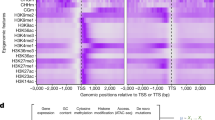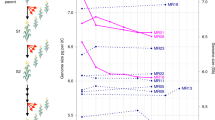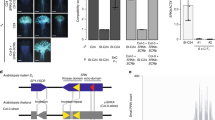Abstract
Evolution is based on genetic variability and subsequent phenotypic selection. Mechanisms that modulate the rate of mutation according to environmental cues, and thus control the balance between genetic stability and flexibility, might provide a distinct evolutionary advantage1,2,3,4. Stress-induced mutations stimulated by unfavorable environments, and possible mechanisms for their induction, have been described for several organisms2,3,4, but research in this area has mainly focused on microorganisms. We have analyzed the influence of adverse environmental conditions on the genetic stability of the higher plant Arabidopsis thaliana. Here we show that a biotic stress factor—attack by the oomycete pathogen Peronospora parasitica—can stimulate somatic recombination in Arabidopsis. The same effect was observed when plant pathogen-defense mechanisms were activated by the chemicals 2,6-dichloroisonicotinic acid (INA) or benzothiadiazole (BTH), or by a mutation (cim3). Together with previous studies of recombination induced by abiotic factors, these findings suggest that increased somatic recombination is a general stress response in plants. The increased genetic flexibility might facilitate evolutionary adaptation of plant populations to stressful environments.
This is a preview of subscription content, access via your institution
Access options
Subscribe to this journal
Receive 12 print issues and online access
$209.00 per year
only $17.42 per issue
Buy this article
- Purchase on Springer Link
- Instant access to full article PDF
Prices may be subject to local taxes which are calculated during checkout




Similar content being viewed by others
References
McClintock, B. The significance of responses of the genome to challenge. Science 226, 792–801 (1984).
Radman, M., Matic, I. & Taddei, F. Evolution of evolvability. Ann. NY Acad. Sci. 870, 146–155 (1999).
Caporale, L.H. Mutation is modulated: implications for evolution. Bioessays 22, 388–395 (2000).
Rosenberg, S.M. Evolving responsively: adaptive mutation. Nature Rev. Genet. 2, 504–515 (2001).
Puchta, H. & Hohn, B. From centiMorgans to base pairs: homologous recombination in plants. Trends Plant Sci. 1, 340–348 (1996).
Walbot, V. Sources and consequences of phenotypic and genotypic plasticity in flowering plants. Trends Plant Sci. 1, 27–32 (1996).
Lebel, E.G., Masson, J., Bogucki, A. & Paszkowski, J. Stress-induced intrachromosomal recombination in plant somatic cells. Proc. Natl Acad. Sci. USA 90, 422–426 (1993).
Puchta, H., Swoboda, P. & Hohn, B. Induction of intrachromosomal homologous recombination in whole plants. Plant J. 7, 203–210 (1995).
Kovalchuk, I., Kovalchuk, O., Arkhipov, A. & Hohn, B. Transgenic plants are sensitive bioindicators of nuclear pollution caused by the Chernobyl accident. Nature Biotechnol. 16, 1054–1059 (1998).
Ries, G. et al. Elevated UV-B radiation reduces genome stability in plants. Nature 406, 98–101 (2000).
Swoboda, P., Gal, S., Hohn, B. & Puchta, H. Intrachromosomal homologous recombination in whole plants. EMBO J. 13, 484–489 (1994).
Puchta, H., Swoboda, P., Gal, S., Blot, M. & Hohn, B. Somatic intrachromosomal homologous recombination events in populations of plant siblings. Plant Mol. Biol. 28, 281–292 (1995).
Mauch-Mani, B. & Slusarenko, A.J. Production of salicylic acid precursors is a major function of phenylalanine ammonia-lyase in the resistance of Arabidopsis to Peronospora parasitica. Plant Cell 8, 203–212 (1996).
Heath, M.C. Hypersensitive response-related death. Plant Mol. Biol. 44, 321–333 (2000).
Uknes, S. et al. Acquired resistance in Arabidopsis. Plant Cell 4, 645–656 (1992).
Ryals, J.A. et al. Systemic acquired resistance. Plant Cell 8, 1809–1819 (1996).
McDowell, J.M. & Dangl, J.L. Signal transduction in the plant immune response. Trends Biochem. Sci. 25, 79–82 (2000).
Yang, Y., Shah, J. & Klessig, D.F. Signal perception and transduction in plant defense responses. Genes Dev. 11, 1621–1639 (1997).
Lawton, K.A. et al. Benzothiadiazole induces disease resistance in Arabidopsis by activation of the systemic acquired resistance signal transduction pathway. Plant J. 10, 71–82 (1996).
Weymann, K. et al. Suppression and restoration of lesion formation in Arabidopsis lsd mutants. Plant Cell 7, 2013–2022 (1995).
Alvarez, M.E. et al. Reactive oxygen intermediates mediate a systemic signal network in the establishment of plant immunity. Cell 92, 773–784 (1998).
Mittler, R. & Lam, E. Characterization of nuclease activities and DNA fragmentation induced upon hypersensitive response cell death and mechanical stress. Plant Mol. Biol. 34, 209–221 (1997).
Gallego, M.E. et al. Disruption of the Arabidopsis RAD50 gene leads to plant sterility and MMS sensitivity. Plant J. 25, 31–41 (2001).
Saxe, D., Datta, A. & Jinks-Robertson, S. Stimulation of mitotic recombination events by high levels of RNA polymerase II transcription in yeast. Mol. Cell. Biol. 20, 5404–5414 (2000).
Maleck, K. et al. The transcriptome of Arabidopsis thaliana during systemic acquired resistance. Nature Genet. 26, 403–410 (2000).
Young, N.D. The genetic architecture of resistance. Curr. Opin. Plant Biol. 3, 285–290 (2000).
Ellis, J., Dodds, P. & Pryor, T. Structure, function and evolution of plant disease resistance genes. Curr. Opin. Plant Biol. 3, 278–284 (2000).
Parniske, M. et al. Novel disease resistance specificities result from sequence exchange between tandemly repeated genes at the Cf-4/9 locus of tomato. Cell 91, 821–832 (1997).
Richter, T.E. & Ronald, P.C. The evolution of disease resistance genes. Plant Mol. Biol. 42, 195–204 (2000).
Tinland, B., Hohn, B. & Puchta, H. Agrobacterium tumefaciens transfers single-stranded transferred DNA (T-DNA) into the plant cell nucleus. Proc. Natl Acad. Sci. USA 91, 8000–8004 (1994).
Acknowledgements
We thank C. Ramos for technical assistance, I. Kovalchuk and J. Molinier for critical comments on the manuscript, and D. Brubacher for help with data analysis. BTH was a gift from H. Kessmann, and K. Lawton supplied PR-1 antiserum. This work was supported by the NOVARTIS Research Foundation, by a grant from the European Union/Swiss Federal Office for Education and Science (to B.H.), a grant from the Swiss National Science Foundation (to J.P.M.) and an EMBO long-term fellowship (to J.M.L.).
Author information
Authors and Affiliations
Corresponding author
Ethics declarations
Competing interests
The authors declare no competing financial interests.
Rights and permissions
About this article
Cite this article
Lucht, J., Mauch-Mani, B., Steiner, HY. et al. Pathogen stress increases somatic recombination frequency in Arabidopsis. Nat Genet 30, 311–314 (2002). https://doi.org/10.1038/ng846
Received:
Accepted:
Published:
Issue Date:
DOI: https://doi.org/10.1038/ng846
This article is cited by
-
Molecular mechanisms and regulation of recombination frequency and distribution in plants
Theoretical and Applied Genetics (2024)
-
Datura genome reveals duplications of psychoactive alkaloid biosynthetic genes and high mutation rate following tissue culture
BMC Genomics (2021)
-
Methylation Status of Arabidopsis DNA Repair Gene Promoters During Agrobacterium Infection Reveals Epigenetic Changes in Three Generations
Plant Molecular Biology Reporter (2021)
-
In Silico Analysis and Comparison of Pathogenesis-related Transcription Factor Binding Sites in Arabidopsis DNA Repair Gene Promoters
Proceedings of the National Academy of Sciences, India Section B: Biological Sciences (2021)
-
Brief temperature stress during reproductive stages alters meiotic recombination and somatic mutation rates in the progeny of Arabidopsis
BMC Plant Biology (2017)



